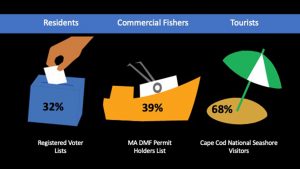Search results for: Australia%20Online%20Pharmacy%20%EF%BF%BD%EF%BF%BD%EF%BF%BD%20www.HealthMeds.online%20%EF%BF%BD%EF%BF%BD%EF%BF%BD%20Price%20Tadalafil%20Australia%20-%20Cheap%20Buy%20Tadalafil%20Australia
The Quantitative Description of Beach Cycles
The Quantitative Description of Beach Cycles Aubrey, D.G. and R.M. Ross Marine Geology, Vol. 69, pp. 155-170, 1985 WHOI-R-85-013 A quantitative method is developed to describe sequential changes in beach profile morphology. The method provides a uniform way to objectively discriminate energetic beach cycles, and yields a concise representation for beach modeling and prediction. It…
Read MoreResearch Measures Views on Seals and Sharks
Newly released research results highlight striking differences and some similarities in the way visitors, voters, and commercial fishermen view seals and white sharks on Cape Cod. The findings of the Woods Hole Sea Grant-funded project can help advance marine conservation, promote responsible stewardship, and foster co-existence. From June to September 2021, representative samples of Cape…
Read MoreNOAALive4Kids coral polyp art
NOAA Live! coral polyp art During the #NOAALive4Kids webinar “Born is the Coral Polyp, A Creation Story from Hawaiʻi”, educator and archaeologist Malia Evans showed you how to design and make coral polyp art. Here are some photos that were shared with us. To view the webinar that was recorded on January 5, 2022, click…
Read MoreConflict Resolution in the Assignment of Area Entitlements for Seabed Mining
Conflict Resolution in the Assignment of Area Entitlements for Seabed Mining Broadus, J.M. and P. Hoagland San Diego Law Review, Vol. 21, No. 3, pp. 541-576, 1984 WHOI-R-84-013
Read MorePerigean Spring Tides — Predicting Potential Disasters: How Tidal Information May Save You From a Coastal Crisis
Perigean Spring Tides — Predicting Potential Disasters: How Tidal Information May Save You From a Coastal Crisis Helpful to educators and students. Giese, G.S. Marine Extension Bulletin, 2 pp., 1998 WHOI-G-98-007
Read More1998-2000 Projects
Dynamics of the Toxic Dinoflagellate, Alexandrium, in the Gulf of Maine: Source Populations and Downstream Impacts Donald M. Anderson, Woods Hole Oceanographic Institution, and Jefferson T. Turner, University of Massachusetts at Dartmouth Toxic algal blooms or “red tides” can cause serious health and economic problems, including Paralytic Shellfish Poisoning (PSP), which occurs when shellfish, zooplankton,…
Read MoreAquaculture is Growing in Southeastern Massachusetts
Aquaculture is Growing in Southeastern Massachusetts Please order poster from: Cape Cod Cooperative Extension, P.O. Box 367, Barnstable, MA 02632. Leavitt, D.F. and W. Burt 19″ x 25″ Poster, $5.00, 1998 WHOI-G-98-003
Read MoreSurf Clams
Surf Clams In the marketplace, one-year-old surf clams are known as “New England Butter Clams” – a relatively new product on the market. Farming New England Butter Clams means they can be harvested at a size in which they are tender, buttery and sweet – as well as easy and versatile to prepare. This results…
Read More#NOAALive4Kids kiʻi pōhaku (petroglyphs)
NOAA Live! kiʻi pōhaku (petroglyphs) During the #NOAALive4Kids webinar “Stories in the Stone: Archaeology in Papahānaumokuākea Marine National Monument”, educator and archaeologist Malia Evans showed you how to design and make kiʻi pōhaku (petroglyphs) that represent you, your family, or your community. Here are some that were shared with us. To view the webinar that…
Read MoreCoastSnap
Becoming a beach scientist is a snap. Share your photos from iconic beaches to help us better understand and manage our dynamic coast. Next time you are at one of our CoastSnap locations, become a scientist for the day by helping us measure how our beaches change over time. What is CoastSnap? CoastSnap is a…
Read More
